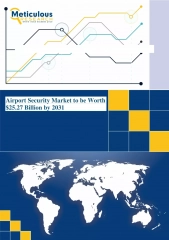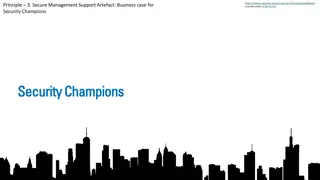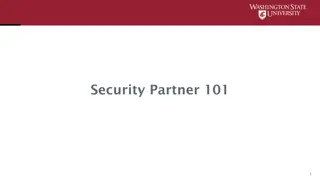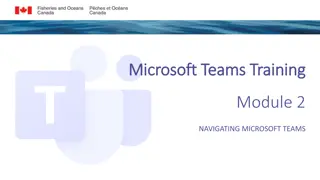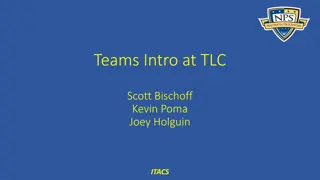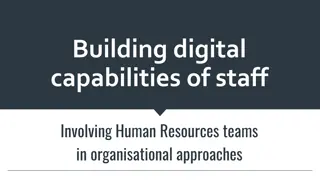Leading Your Security Teams in a Changing Environment
Explore valuable insights on leading security teams amidst a dynamic environment with Barbara Stankowski, a seasoned expert in the field. Gain strategies to navigate challenges and empower your team for success in the ever-evolving security landscape.
Uploaded on Mar 01, 2025 | 0 Views
Download Presentation

Please find below an Image/Link to download the presentation.
The content on the website is provided AS IS for your information and personal use only. It may not be sold, licensed, or shared on other websites without obtaining consent from the author. Download presentation by click this link. If you encounter any issues during the download, it is possible that the publisher has removed the file from their server.
E N D
Presentation Transcript
Leading Your Security Teams in a Changing Environment Barbara Stankowski President/CEO/Owner
What is changing? Globally Technology Economics Threats Privacy Security Unexpected Disaster (fire, hurricane, flood, etc.) Organizationally Technology Security Arena impacting DSS and Defense contractors Insider Threats From JPAS to DISS From eFCL and ISFD to NISS NIST Controlled Unclassified Information(CUI) IT system cybersecurity RMF Classified Systems
Change: Digital Transformation Reshaping and changing everything: Business Communities People Nations
Change: Disaster Preparedness Hurricane Irma The U.S. Small Business Administration (SBA) approved 41,264 disaster loans for a total of $1.7 billion after Irma. 4,767 business disaster loans have been approved for $393 million. Disaster Preparedness: After a Disaster (power outage, storm surge, fire) 40% of small businesses never reopen 70% did not have a disaster recovery plan IT Security 68% of small businesses close down within 6 months after a cyber attack.
Change: What a Difference a Century Can Make Characteristic 20th Century 21st Century Organization The Pyramid The Web or Network Focus Internal External Style Structured Flexible Source of Strength Stability Change Structure Self-sufficiency Interdependencies Resources Atoms Physical Assets Bits Information Operations Vertical Integration Virtual Integration Products Mass Production Mass Customization Reach Domestic Global Data: Business Week
Speed of Change Ever Increasing The doubling of computer processing speed every 18 months, known as Moore's Law, is just one manifestation of the greater trend that all technological change occurs at an exponential rate. Eighteen to twenty years out, technological innovation will be hundreds of thousands to a million times more advanced. Three dimensional processors and memory drives along with biological, photon, and quantum computing will keep the rate of information improvement at an exponential pace. As a leader of your organization: Do you know what industries are headed for oblivion right now? Is yours? Do you have the foresight that will keep you and your organization relevant in the next three to five years?
Impact of Change Whenever human communities are forced to adjust to shifting conditions, pain is ever present. John P. Kotter Leading Change, 1996
Creating a Corporate Culture for Change General George Patton We have to be able to change, or we will get the hell shot out of us. Nothing ever stays the same in war. Winston Churchill To improve is to change, to be perfect is to change often.
Change Impacts at a Personal and an Organizational Level Organizational Context: Personal Context: New actions, policies, and behaviors for the organization Altering how we act, think, and feel as individuals
Phases of Change Denial Commitment F u t u r e P a s t Exploration Resistance (Figure adapted from Elizabeth Kubler-Ross phases of coping)
The Leaders Challenge In today's complex global business environment, it's no longer enough to merely respond to change. Successful leaders must be able to anticipate the impact of: marketplace adjustments new regulatory requirements a change in business strategy implementation of new technology within their organizations The leader s challenge is to develop a holistic approach to change: to create an agile culture that embraces change while promoting organizational resilience Security needs to be an integrated component of the corporate culture
Transformational Change: An 8 Stage Process 1. Establish a sense of urgency. 2. Create the guiding coalition. 3. Develop a vision and strategy. 4. Communicate the change vision. 5. Empower broad-based action. 6. Generate short-term wins. 7. Consolidate gains and produce more change. 8. Anchor new approaches in culture. John P. Kotter, Leading Change, pg. 21
Strategic Change Model Strategic Phases Tactical Phases Evaluate/ Institutionalize Assess Establish Direction Plan Implement Change Management Enterprise Team Support Available Determine the Need for Change Articulate the problem Develop the Vision and Strategy Image of future state Alignment with strategic goals Desired outcomes Measures of success Create a Guiding Coalition Identify leaders with the power, expertise and credibility to drive change Obtain leadership buy-in Empower Broad-based Action Execute plan, remove barriers to change (structural, skills, systems, behaviors) Measure Obtain Feedback Assess progress Develop Integrated Transition Plan Vision/Strategy Communications Training Human Resources Metrics BU/Site Transition Plans Establish a Sense of Urgency Consequences Dealing with complacency Time sensitivity Communicate the Change Leadership by example Repetition Stories, metaphors Multiple forums Two-way communication Refine and Stabilize Processes and Organization Assess the Environment Marketplace drivers Culture/Values Stakeholder needs Potential impact(s) on those affected Perceptions/Priorities Fallback Socialize the Vision and Outcomes Gain feedback Identify issues Decision to move forward Generate Short-Term Wins Implementation Team (organic support used) Who must do what? Small Exploratory Group (Consultant Support Available) Where are we now? Design Team Where do we want to be? How will we get there? How are we doing? * Incorporates Eight-Stage Process of Creating Major Change John P. Kotter, Harvard Business School
Leaders Role in Change No longer dealing with one organizational or several changes at a time Instead must be focused on developing a culture that embraces change/disruption with not just the leader but a large numbers of leaders throughout the organization who embrace: An accelerated sense of urgency Rapid adoption of technology shifts Agility so the organization adapt quickly Just-in-time decision making Thinking out of the box Rapid implementation and elimination of road blocks A compelling vision of the future that incorporates ever accelerating change and disruption
It Starts with the Leader: Modeling the way by embracing change and not being a roadblock to change Encouraging the heart Inspiring a shared vision of an agile, responsive corporate culture Constantly challenging the current process, the we have always done it this way Enabling others to act; leadership at all levels of the organization The Leadership Challenge Kouzes and Posner

 undefined
undefined





